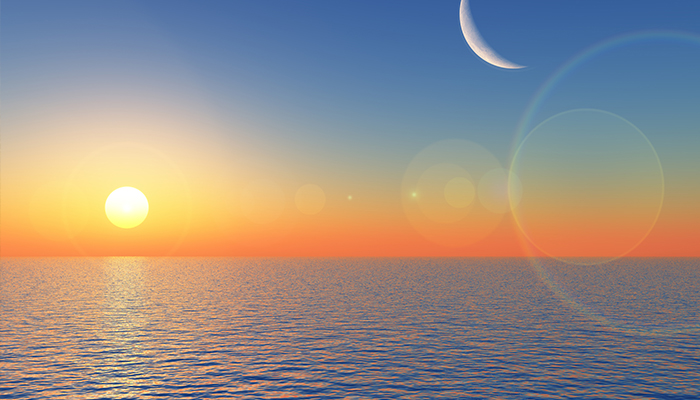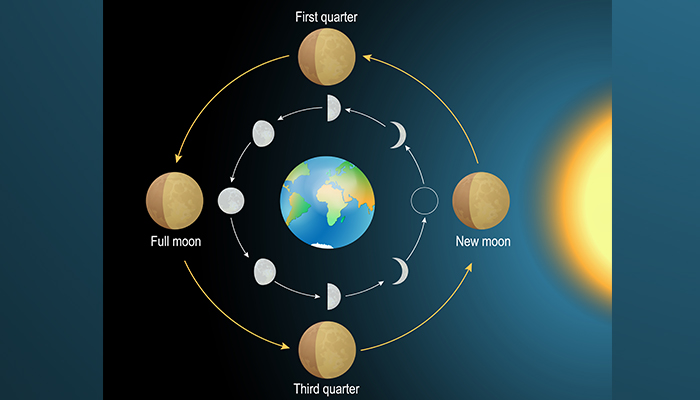When Can I See You Again?
Professor Orsola De Marco, from Macquarie University's Department of Physics and Astronomy, explains.
The answer to this question is ultimately "why not". The Moon is super brilliant when it'southward suitably illuminated by the Sun, so even during the 24-hour interval it tin can be easy to see.

Double delight: The Moon revolves around the World nearly one time every 28 days, and is visible past day – as depicted in this illustration – for nigh half the month, explains De Marco.
And then, here is how it works. The Globe spins on its axis once a day and rotates around the Sun once a year, that we all know. Still, from our bespeak of view on Earth, information technology is the Sun that orbits us once a day, correct?! Because of that, nosotros see the Sun rise from the east and fix in the west. And there is the minor boosted complexity that the World'southward rotational axis is not perpendicular to its orbital plane around the Dominicus, it is instead inclined at approximately 23 degrees. This is, by the style, what gives u.s. our seasons.
At present, let's come back to our master topic: the Moon by day. The Moon is a rock. It has no calorie-free of its own and the reason we encounter it is that it reflects the Lord's day's light. The Moon revolves effectually the Earth approximately one time every 28 days.
Some other fact is that the Moon orbits on a airplane that is almost aligned with the orbital plane of the Earth around the Sun. This fact is not too important to understanding the Moon by day, but it has all kinds of nice implications.
1 is that if the Moon orbited exactly on the same aeroplane as the orbit of the World around the Dominicus, nosotros would get one solar eclipse and 1 lunar eclipse per month. This is because in one case per lunar revolution the Moon would pass exactly between the Earth and the Sun (resulting in a solar eclipse for some of Earth'southward citizens) and pass exactly behind the Earth and the Sun, such that the Earth would cast its ain shadow on the Moon (and all Earth's citizens on the side of the world facing the moon would run across a lunar eclipse). But once more, this factoid is not as well relevant to the Moon by twenty-four hours.
Nosotros are sitting on a speck of dust in the large Universe. Surely we should pay more attention to what's out there!
The lunar orbit only means that the relative position of the Moon and Sun in the heaven changes over the class of approximately a calendar month. They are completely independent of one another. Sometimes they are shut to 1 another in the heaven; sometimes they are at opposite sides of the Earth.
They literally don't intendance whether they are near or not (annotation: the Lord's day and Globe are never physically most ane some other. When I say 'near' I hateful near from our vantage point looking upwards at the heaven).
- When will Australia'southward volcanoes erupt?
- The suburb earmarked to host Sydney's first national park in the sky
Let's think of information technology this way. Imagine that your head is the unabridged Earth. You are also belongings a mirror in your hand, with your arm outstretched. You can imagine that, right? Now switch on a bedside light a few metres away and turn away from the lite. With your mirror stretched out in forepart of yous, angle it then that you run into the low-cal reflected in information technology, tin can you? You only need to make sure that your caput is non exactly between the calorie-free and the mirror (that is called an eclipse).
If your head is not exactly in the way, then y'all can find a way to see the lite behind you, reflected in the mirror. This is the situation where the Sun – the calorie-free – is backside you lot so that information technology is day for the people living on the dorsum of your head, and the Moon, the mirror, reflects the light of the Sun so that you, on the front of your head, tin see the Moon. The dorsum of your head is in daylight, and the dwellers there run across the Lord's day high in their sky, while you lot, at the front of your caput encounter the Moon in the night sky. I should add together: this is full moon for yous.

Lunar calendar: The phase of the Moon is the shape of the directly sunlit portion of the Moon as viewed from Earth.
But you lot asked me why we see the Moon in the day time! I know! So now, turn around so that the lite bulb is not directly in forepart of you lot, simply kind of a piddling to your left, in such a position that you can see it improve with your left middle than your correct center.
Withal, you lot tin argue that your face is still in daylight considering you can see the light bulb. You are still holding the mirror in forepart of you, yeah? Now bending the mirror so that you can see the light bulb reflected in it. You are going to have to angle that mirror quite a bit, but yous tin can do it. Now you lot can come across the light seedling AND you can see the reflection of the lightbulb in the mirror! This is the case when you directly see the Lord's day and also the Moon in the daytime.
As you can imagine, you lot demand to angle the mirror quite a flake in gild to catch the light from the Sun. This is why if you see the Moon during the day, and specially if it is not very far from the Sun, so you simply come across a slither. On the other manus, if the Moon in the day sky is quite afar from the Dominicus, and then yous probable will come across more of its illuminated surface - a half moon.
Once a educatee told me that after taking our solar organisation class he was much more curious about the heavens and often looked upwards to pinpoint the Moon, the Cross and the planets. And nosotros should look upwards more! Nosotros are sitting on a speck of dust in the large universe. Surely we should pay more attention to what's out there.
Orsola De Marco is a professor in the Department of Physics and Astronomy at Macquarie University.
This article was first published on September 26, 2019.
Source: https://lighthouse.mq.edu.au/article/please-explain/september-2019/why-can-you-see-the-sun-and-the-moon-at-the-same-time
0 Response to "When Can I See You Again?"
Post a Comment